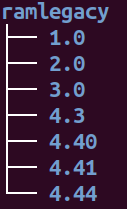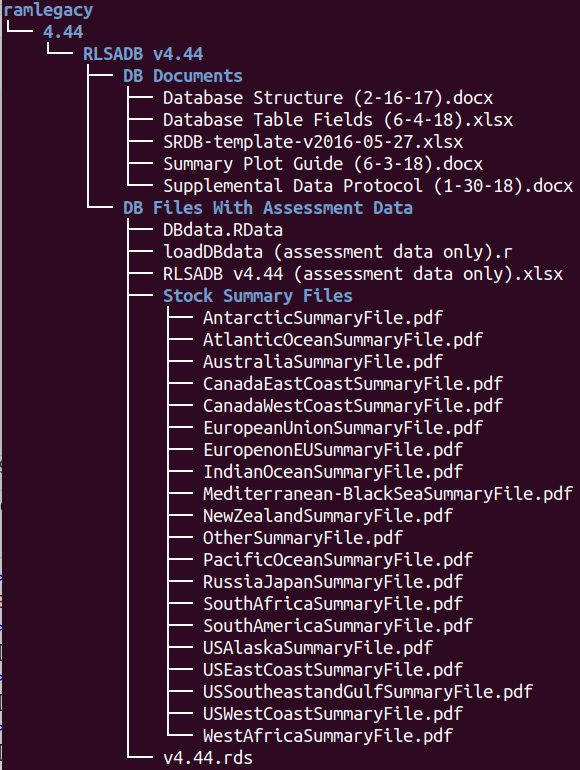
Introduction to ramlegacy
Carl Boettiger & Kshitiz Gupta
2025-12-16
Source:vignettes/ramlegacy.Rmd
ramlegacy.RmdRAM Legacy Stock Assessment Database
From the database’s website:
The RAM Legacy Stock Assessment Database is a compilation of stock assessment results for commercially exploited marine populations from around the world. It is inspired by Dr. Ransom A. Myers’ original stock-recruitment database, which is no longer being updated.”
As of April 2019, the available versions are 1.0, 2.0, 2.5, 3.0, 4.3, 4.40, 4.41, 4.44.
The latest versions of the database (4.44, 4.41, 4.40) are available
at Zenodo. This is
where download_ramlegacy downloads the database from.
The older versions of the database (4.3, 3.0, 2.5, 2.0, 1.0) are available in Excel (Microsoft Excel Open XML Format Spreadsheet) format at this github repo.
About the package
The goal of ramlegacy is to cache a specified version(s)
of the RAM Legacy Stock Assessment Excel Database and this way save time
and effort spent in re-downloading different versions of the database as
part of any future analysis involving the data. The package also
supports reading in any specified dataframe(s) of the database through a
function called load_ramlegacy(). The user can always view
the location to which the database is cached and read from by running
ram_dir() and specifying its version argument. This
vignette will outline a few more details about these functions and the
package that will hopefully make ramlegacy easy to use.
Package Installation
You can install the development version from github with the
install_github function available in devtools
package:
install.packages("devtools")
library(devtools)
install_github("ropensci/ramlegacy")To ensure that the vignette is installed along with the package make
sure to remove --no-build-vignettes from the
build_opts in install_github
download_ramlegacy
You can download any available version of the RAM Legacy Stock
Assessment Excel Database (“1.0”,“2.0”, “2.5”, “3.0”, “4.3”, “4.40”,
“4.41”, and “4.44”) through download_ramlegacy():
# download version 1.0
download_ramlegacy(version = "1.0")
# download version 2.0
download_ramlegacy(version = "2.0")
# download version 2.5
download_ramlegacy(version = "2.5")
# download version 3.0
download_ramlegacy(version = "3.0")
# download version 4.3
download_ramlegacy(version = "4.3")
# download version 4.44
download_ramlegacy(version "4.44")If version is not specified then download_ramlegacy will
default to downloading the latest version of the database:
# downloads latest version (currently 4.44)
download_ramlegacy()If you want to download multiple versions please download them one at a time as passing them all at once will throw an error.
To enable caching behavior, before downloading the specified version
download_ramlegacy checks whether that version has already
been downloaded. If it is then download_ramlegacy gives the
user the option to either download again and overwrite the existing
version or not download and just exit the function. This behavior is
modified if overwrite, a function argument to
download_ramlegacy, is set to true. Then even if the
version has already been downloaded calling
download_ramlegacy will download it again overwriting the
already present version. After downloading the database
download_ramlegacy caches it by converting it to an RDS object which can
then be read in through calling load_ramlegacy().
download_ramlegacy also has three other arguments:
ram_path, ram_url, and quiet. By
default ram_path has been set to a location provided by the
rappdirs package and can be viewed by calling
ram_dir(vers = "version"). Although this is not the
recommended approach download_ramlegacy supports downloading to
a user-specified path. ram_url is fixed to the zenodo URL
of the database. Please do not pass in any other url to
ram_url. By default, download_ramlegacy after it is called
keeps the user updated of the download progress through status messages.
Setting quiet to TRUE enables the user to suppress all
status messages.
File Structure of Downloaded Database
This section illustrates the contents and file structure of the
directory to which the database is saved once you call
download_ramlegacy
If you have downloaded multiple versions through
download_ramlegacy() the contents of ramlegacy directory
(the path to this directory can be viewed by calling
ram_dir()) on your local computer will look something like
this with each version getting its own subdirectory within the
directory:

For older versions (1.0, 2.0, 2.5, 3.0, 4.3) the contents of the version subdirectory look like this:

For these older versions, the version subdirectory would contain the
excel database and serialized database saved under the names
RLSADB v <version no> (assessment data only).xlsx and
v <version number> .rds respectively.
For newer versions (4.40, 4.41, 4.44) along with the excel file of the database file other documents like stock summary files are also downloaded:

The actual excel file of the database and the serialized rds database
will be present as
RLSADB v <version no> (assessment data only).xlsx and
v <version no> .rds respectively inside the
DB Files With Assessment Data folder.
Description of Tables and Stock Summary Files within the Database
For a description of the dataframes present in the database as well as information on the stock summary files present in the database please see this page.
load_ramlegacy
load_ramlegacy can be used to obtain a list of
particular dataframes and passed in to the tables argument.
To get a list of all the dataframes within a specific version of the
database set tables = NULL. Make sure that the version you
want to load was downloaded and is already present locally at the path
you specify using ram_path otherwise
load_ramlegacy will throw an error.
# returns a list containing area and bioparams tables from version 4.44 database
load_ramlegacy(version = "4.44", tables = c("area", "bioparams"))In case in you want to load multiple versions please load them one at
a time as passing them all at once will throw an error. Similar, to
download_ramlegacy, load_ramlegacy has a
ram_path argument which is set to local directory where the
specified version of the RAM Legacy Stock Excel Assessment Database was
downloaded. You can view that path through
ram_dir(vers = "version"). Although this is not the
recommended approach load_ramlegacy supports reading in the
database’s dataframes from a user-specified path provided that the
database is present at the specified path as an rds file.
ram_dir
To see the path of the directory where the specified version of
database was downloaded on the user’s computer, the user can call
ram_dir. Note that this is also the location from which
load_ramlegacy reads in the database.
For example, to see where version 4.3 of the database was downloaded you can call:
# view the path where version 4.3 of the database was cached
ram_dir(vers = "4.3")